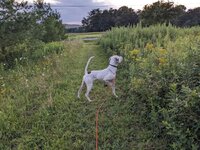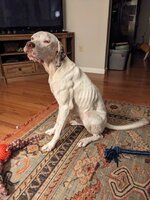PSDBowhunter
Lil-Rokslider
I have a 3 yr old english pointer that my cousin gave me because their family could no longer care for him. He came to us looking very muscular and well put together. I take him on hikes and runs and generally let him out around the house to "hunt" for birds, rabbits, etc. He gets a lot of activity at our house. Since we've had him for 6 months or so, he is noticeably thinner despite my best efforts to give him high quality dog food (PPP 30/20). I feed him 3 times per day and give him 2 cups per feeding for a total of 6 cups (which seems like an awful lot to me). We took him to the vet the other month and they said they couldn't find anything wrong with him. He was a little lighter than they would typically like to see, but otherwise a very healthy dog.
Have any of you dealt with this? Do I just need to limit his activity? Or give him supplemental fats with his food?
Have any of you dealt with this? Do I just need to limit his activity? Or give him supplemental fats with his food?


